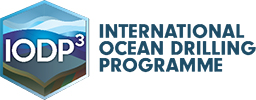International Ocean Drilling Programme (IODP³) D/V Chikyu Completes Expedition 502: Impact of Petit-Spot Magmatism on Subduction Zone Seismicity and Global Geochemical Cycles (T-Petit)


The Deep-Sea Scientific Drilling Vessel Chikyu*1, operated by the Japan Agency for Marine-Earth Science and Technology (JAMSTEC: Hiroyuki Yamato, President), has completed the International Ocean Drilling Programme (IODP³)*2 Expedition 502: Impact of Petit-Spot Magmatism on Subduction Zone Seismicity and Global Geochemical Cycles (T-Petit), on 24 November (Tue) 2025, having achieved its objectives.
1. Operation Summary
This expedition started on 30 October 2025, where drilling using the deep-sea drilling vessel Chikyu (previously reported on October 20, 2025), to include borehole logging and core sampling, was conducted at a site on the outer rise area of the Japan Trench, where the sediment layer above the acoustic basement is exceptionally thin (Fig.1, Fig.2).
The borehole logging conducted during this expedition employed a different methodology from previous operations to ensure reliable logging within the shallow, hard rock layer below the seafloor (Fig.3). While this technique has a proven track record in land-based drilling, its implementation on a drilling vessel or semi-submersible rig represented a world first. Through extensive preparatory work and meticulous execution, the target geological data was successfully acquired.
For core sampling at Hole C0027D, core samples were collected from the shallow sedimentary layer down to 62 m below seafloor and from the igneous rock layer between 62 and 67.5 m. Core samples were collected from depths of 59 to 106.5 meters below the seabed in Hole C0027E, and from depths of 56 to 63 meters below the seabed in Hole C0027F. Subsequently, Chikyu entered Sendai Port (Takamatsu Second Pier), Miyagi Prefecture, on 23 November, concluding this expedition.
2. Overview of Results and Future Plans
On this expedition, geological data and sample collection via borehole logging and core sampling were conducted at the Pacific Plate, which subducts at the Japan Trench. The data and samples obtained are expected to verify whether the petit-spot volcanic activity, presumed to exist beneath the seafloor at a water depth of approximately 5,400 meters, extends over a wider area than previously thought. Furthermore, they expect to clarify the role that petit-spot plays in earthquake generation within subduction zones and in global material cycling.
3. Expedition website
A dedicated website for the expedition was launched. This website provides an overview of the expedition, introduces the participating researchers, and has been updated throughout the expedition.
https://www.jamstec.go.jp/chikyu/e/exp502/
DV Chikyu
The Japanese Drilling Vessel provided for IODP³ Scientific Ocean Drilling

Chikyu©JAMSTEC/IODP³
International Ocean Drilling Programme(IODP3)
Launched in 2025 as the successor program to the IODP, which concluded in 2024. This initiative is led by Japan and ECORD (European Consortium for Ocean Research Drilling). Using the drilling platforms provided by Japan (Chikyu) and ECORD (MSP), respectively, the International Ocean Drilling Programme (IODP³) is an international marine research collaboration that explores Earth’s history and dynamics using ocean-going research platforms to recover data recorded in seafloor sediments and rocks and to monitor subseafloor environments.

Fig.1 Survey Area

Fig.2 Drilling Plan
The following operations were carried out at Site C0027 (Proposed Site TPC-01A), where four boreholes were drilled.
- Borehole logging
In Hole C0027C, drilling proceeded in a water depth of approximately 5,477.5 meters / 98.0 meters below seafloor (mbsf). Three borehole logging sessions were conducted using different logging measurement tools. - Core sampling of shallow sedimentary layers
In Hole C0027D, cores were collected using a Hydraulic Piston Coring System (HPCS)/ Extended Shoe Coring System (ESCS) down to 67.5 mbsf, primarily from sedimentary deposits. - Collection of rock core samples
In Hole C0027E and Hole C0027E, the Small Diameter Rotary Core Barrel (SD-RCB) was used to collect cores, primarily of igneous rock, down to 106.5 mbsf.

Fig.3 Borehole Logging
After landing the bit at the target depth within the borehole, logging was conducted (Tool Run). After confirming that the logging tool had landed directly above the bit, the wireline was released and retrieved aboard the vessel (Wireline Trip). Subsequently, logging was performed whilst raising the drill pipe (Log up). Following completion of measurements, the logging string was hauled in. During this expedition, three logging runs were conducted using different measurement tools.

Photo 1. (4 November) The drill bit used during drilling Hole C0027C. The left images show the drilling bottom hole assembly (BHA) before (L) and after (R) drilling. The close-up images of the drilling bit show the cutting faces of the drill bit before (L) and after (R) drilling.

Photo 2. (13 November) Core sample collected by the SD-RCB, including the boundary between sediment and igneous rock.
For IODP³ and the expedition,
For press release